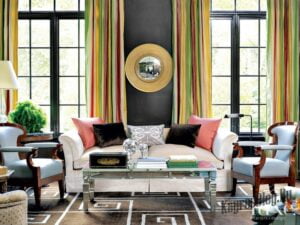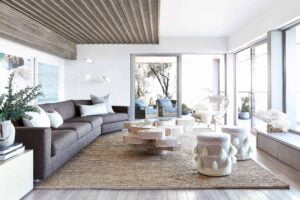In the world of interior design, the principles of rhythm and harmony hold immense importance. They go beyond mere aesthetics, profoundly impacting our well-being and subconscious experience within a space.
A well-designed place may foster tranquility, increase productivity, and enhance our quality of life from the moment we step inside because of its rhythmic flow and harmonious balance. In this article, we'll examine the significance of rhythm and harmony in Interior Design and how they impact the way our environments are created.
1. Creating a Sense of Balance

Rhythm and harmony play a vital role in establishing visual equilibrium within a space. By incorporating elements of proportion, scale, and symmetry, Designers can achieve a harmonious balance that promotes a sense of tranquillity and order. Balanced spaces have a calming effect on our minds.
2. Establishing Visual Flow
Rhythm is the repetition or progression of Design elements that create a sense of movement and flow throughout a space. Whether it's through repeating patterns, color schemes, or architectural features, a well-executed rhythm guides our eyes and draws us naturally from one area to another.
3. Enhancing Well-Being
Our well-being is significantly impacted by Home Design's rhythmic and aesthetically pleasing features. Studies show that workplaces with a strong sense of rhythm and harmony can reduce stress, promote relaxation, and increase productivity. We feel more unified and at ease when our surroundings have a well-balanced and smooth rhythm.
4. Supporting Cognitive Processes
The presence of rhythm and harmony in interior design influences our cognitive processes and subconscious mind. A well-organized and harmonious environment can stimulate creativity, improve focus, and enhance cognitive function. The human brain responds positively to patterns and order, making spaces with rhythmic elements more conducive to learning and problem-solving.
5. Expressing Personal Style
Rhythm and harmony offer a framework for expressing our unique personal style in interior design. By understanding the principles of rhythm and harmony, individuals can create spaces that reflect their personalities and preferences.
6. Influencing Mood and Emotions

Rhythm and harmony have the power to evoke specific moods and emotions within a space. The careful arrangement of elements can create a sense of calmness, excitement, or even nostalgia.
7. Connecting with Nature
Designing Interiors with rhythm and harmony can help people feel more connected to nature because nature itself is a masterful example of these concepts.
Designers can produce environments that suggest a sense of harmony with the environment by incorporating organic designs, natural materials, and a color palette inspired by nature.
Types of Harmony
Symmetrical Harmony
Symmetrical harmony involves creating a balanced and mirror-like arrangement of design elements. It follows a formal approach, where objects or patterns are evenly distributed on either side of a central axis, resulting in a sense of stability and order.
Asymmetrical Harmony
Asymmetrical harmony introduces a more dynamic and informal approach to design. It involves balancing different elements with varying visual weights, colors, and textures. Although asymmetrical compositions lack perfect symmetry, they create a harmonious equilibrium through careful arrangement and consideration of visual relationships.
Complementary Harmony
Complementary harmony utilizes contrasting colors from opposite sides of the color wheel. By pairing colors that are opposite each other, such as red and green or blue and orange, a vibrant and energetic visual impact is achieved. Complementary harmony creates a sense of tension and excitement while still maintaining balance.
Analogous Harmony
Analogous harmony involves using colors that are adjacent to each other on the color wheel. This harmony creates a more soothing and unified effect as the colors share similar undertones. For example, using shades of blue and green together in a space creates a calming and cohesive atmosphere.
Types of Rhythm

Repetitive Rhythm
Repetitive rhythm involves the repeated use of design elements, such as patterns, shapes, or colors, throughout a space. This creates a predictable and ordered visual flow, leading the eye from one element to the next. Repetition can bring a sense of unity and coherence to an interior design scheme.
Progressive Rhythm
Progressive rhythm involves the gradual change or progression of design elements in a space. It introduces a sense of movement and growth, capturing the attention and drawing the eye toward a focal point. This type of rhythm can be achieved through a sequence of changing sizes, shapes, or colors.
Alternating Rhythm
Alternating rhythm involves the use of two or more different design elements that repeat in a consistent pattern. It creates a sense of variety and interest within a space, as the eye alternates between different visual elements. Alternating rhythm adds a dynamic quality and can be achieved through the repetition of contrasting colors, textures, or shapes.
Random Rhythm
Random rhythm breaks away from strict patterns and repetitions, introducing an element of surprise and spontaneity. It involves the irregular placement of design elements, creating a more organic and naturalistic feel. Random rhythm adds a sense of energy and vitality to a space, evoking a less formal and more eclectic ambiance.
Conclusion:
In Interior Design, rhythm, and harmony are essential for transforming spaces and improving our well-being. They bring balance, flow, and a sense of order to our surroundings, influencing our emotions and subconscious.
By incorporating these principles, we can create aesthetically pleasing spaces that nurture our well-being, enhance cognitive processes, and uplift our spirits. Let's embrace the dance of design and harmonize our living spaces to enrich our lives.
